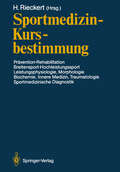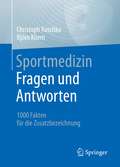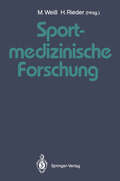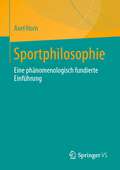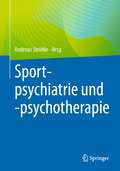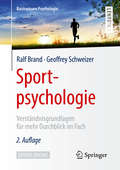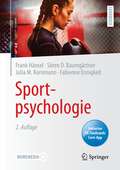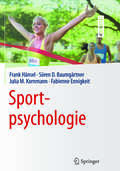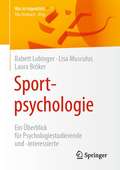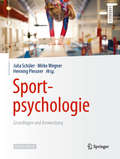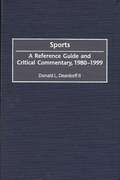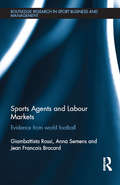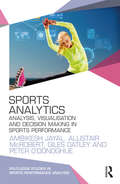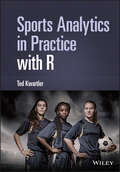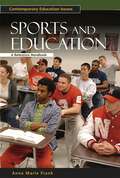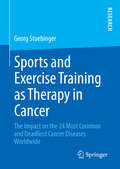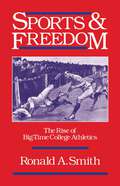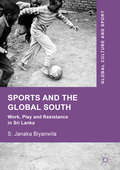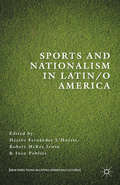- Table View
- List View
Sportmedizin — Kursbestimmung: Prävention — Rehabilitation, Breitensport-Hochleistungssport, Leistungsphysiologie, Morphologie, Biochemie, Innere Medizin, Traumatologie, Sportmedizinische Diagnostik Deutscher Sportärztekongreß Kiel, 16.–19. Oktober 1986
by Hans RieckertDas Buch enthält die Vorträge des Deutschen Sportärztekongresses 1986 in Kiel. Die Themen dokumentieren umfassend die Bedeutung der Sportmedizin in Prävention und Rehabilitation. Sie geben einen aktuellen Überblick über die gegenwärtigen Forschungsschwerpunkte der Sportmedizin und bieten dem Leser einen Einblick in das Aufgabenfeld und in Problemstellungen der heutigen Sportmedizin.
Sportmedizin - Fragen und Antworten: 1000 Fakten für die Zusatzbezeichnung
by Christoph Raschka Björn KliemStehen Sie als Arzt kurz vor Ende der Zusatz-Weiterbildung oder wollen Sie in der Sportmedizin arbeiten?Dann können Sie Ihr Wissen mit diesem Taschenbuch optimal überprüfen! Über 1000 Fragen mit offenen und teilweise sehr ausführlichen Antworten bringen Sie auf den aktuellen Stand von Themen der Sportmedizin, wie z. B. Energiebereitstellung, Leistungsdiagnostik, Sportkardiologie, Sportorthopädie, Rehabilitation, Sporternährung, Höhenphysiologie, Tauchmedizin und vielem mehr. Mit diesem Buch können Sie sich systematisch und selbstständig auf die mündliche Abschlussprüfung vorbereiten. Die Fragen orientieren sich am Weiterbildungsinhalt der Zusatz-Weiterbildung Sportmedizin (WBO 2020) sowie dem (Muster-)Kursbuch Sportmedizin der BÄK. Die Fragen und Antworten wurden so formuliert, wie sie in einer mündlichen Prüfung vorkommen können bzw. sollten. So erhalten Sie Sicherheit bezüglich der Grundlagen der Sportmedizin, der spezifischen sportmedizinischen Aspekte, der Sportmedizin bei Erkrankungen und bezüglich der praktischen sportärztlichen Tätigkeit in der Praxis oder am Spielfeldrand.
Sportorthopädie und -traumatologie im Kindes- und Jugendalter: Sporttauglichkeitsprüfung und Sport bei Verletzungen und Erkrankungen
by Holger SchmittSport im Kindes- und Jugendalter trotz Verletzung oder ErkrankungSport im Kindesalter fördert die Gesundheit und hat zahlreiche positive Effekte auf die Entwicklung., Verletzungen und Erkrankungen, die typischerweise im Kindesalter auftreten, können die Sportfähigkeit teilweise erheblich beeinflussen. Wie in diesen Fällen behandelt wird und welchen Einfluss die Behandlung auf die Sportfähigkeit hat, wird im ersten Teil des Buches aufgezeigt. Wird in junge Jahren schon intensiv Sport getrieben, kann der Bewegungsapparat an die Belastungsgrenze geführt werden. Bei welchen Sportarten welche Risiken bestehen und welche Maßnahmen ergriffen werden könne, um das Risiko zu reduzieren, wird im zweiten Teil de Buches dargestellt. Auswirkungen auf den Schul- und Vereinssport sind jedem Kapitel beigefügt. Die Neuauflage wurde aktualisiert und mit Kapiteln zur Leistungsfähigkeit, Prävention, Sonographie und einigen Sportarten, wie z. B. Klettern erweitert.Das Buch richtet sich an Ärzte, Physiotherapeuten, Trainer, Übungsleiter und soll als Behandlungshilfe dienen, um Kindern und Jugendlichen eine möglichst optimale Rückführung zum Sport zu ermöglichen.
Sportphilosophie: Eine phänomenologisch fundierte Einführung
by Axel HornDie Einführung gibt einen Überblick über Inhalte und Methoden, holt den Leser mit seinen Vorverständnissen über Philosophie und Sport ab und eröffnet den Horizont für Themen, Fragen, Problemstellungen und Lösungsansätze einer Sportphilosophie.Der zweite Teil des Buches beschäftigt sich mit der Phänomenologie als einer der grundlegenden Strömungen der Philosophie des 20. Jahrhunderts. Er zeichnet Anliegen und Entwicklung der Phänomenologie anhand einiger ihrer Hauptvertreter nach und arbeitet mit „Phänomenologien der Leiblichkeit“ ein zeitgemäßes Verständnis von Körper respektive Leib heraus.Im dritten Teil geht es um eine „Phänomenologie des heutigen Sports“. Sport ist längst eine feste gesellschaftliche Größe und ein florierender wirtschaftlicher Bereich geworden. Das Buch analysiert die Verbindung des Sports zu Geld, Macht, Politik, Medien, Doping und die Rolle, die er hinsichtlich Körperkult, Spiel, Gesundheit, Bildung usw. spielt. Der Autor geht den Fragen nach, wie sich die Phänomene genauer darstellen, was sie „eigentlich“ zum Vorschein bringen, und ob der Sport tatsächlich einem Umgang mit dem Körper respektive dem Leib entspricht, wie er im philosophischen Verständnis der Leiblichkeit dargelegt wurde.
Sportpsychiatrie und -psychotherapie
by Andreas StröhleDie Sportpsychiatrie und -psychotherapie ist im deutschsprachigen Raum eine noch jüngere Spezialisierung, während Sportmedizin in Deutschland inzwischen eine fächerübergreifende ärztliche Zusatzweiterbildung darstellt. Sportpsychiatrische Kenntnisse und Expertise gewinnen jedoch sowohl im Breiten- als auch im Leistungssport zunehmend an Bedeutung, nicht zuletzt durch Erkrankungen prominenter Leistungssportler und die Diskussion ihrer Ursachen und Folgen. Auch in der Entstehung und Behandlung psychischer Erkrankungen in der Allgemeinbevölkerung kommt der Rolle von Bewegung und Sport eine immer größere Bedeutung zu. Dieses Buch bringt diese beiden Aspekte der Sportpsychiatrie und -psychotherapie zusammen. Namhafte Autoren aus der Sportmedizin, Physiologie, Psychologie, Sportpsychologie, Psychiatrie und Psychotherapie bieten zunächst einen Überblick über die Grundlagen von Sport, Bewegung und Training sowie Basiskenntnisse der Leistungs- und Sportpsychologie. Das Kernstück des Buches umfasst die Darstellung der Sport- und Bewegungstherapie bei psychischen Erkrankungen in der Allgemeinbevölkerung einerseits sowie der psychischen Erkrankungen und Besonderheiten bei (Leistungs-)Sportlern andererseits. Das Werk richtet sich an Therapeuten und Ärzte unterschiedlicher Disziplinen, insbesondere Psychiater und Sportmediziner, aber auch Psychologen und Psychotherapeuten sowie andere Berufsgruppen in Medizin, Psychiatrie und Psychotherapie, die sich für Sport und Sporttherapie interessieren. Daneben sollen aber auch Helfer und Professionelle aus dem Sport angesprochen werden, um einen Zugang zu psychischen Erkrankungen im Leistungssport zu bekommen.
Sportpsychologie: Verständnisgrundlagen für mehr Durchblick im Fach (Basiswissen Psychologie)
by Ralf Brand Geoffrey SchweizerWomit beschäftigt sich die moderne Sportpsychologie? Wie beeinflusst und trainiert man psychische Grundvoraussetzungen von Spitzenleistungen? Weshalb gelingt es manchen Menschen nach jahrelanger körperlicher Inaktivität ihrer Gesundheit zuliebe mit Sport zu beginnen, anderen aber nicht? Wie beeinflussen körperliche Aktivität und besonders Sport das psychische Wohlbefinden oder die Persönlichkeitsentwicklung? Die Sportpsychologie ist ein vielfältiges, breites und faszinierendes Forschungs- und Anwendungsgebiet an der Schnittstelle zwischen Psychologie und Sportwissenschaft. Das Buch führt in klarer, verständlicher Form in die Grundlagen der Sportpsychologie ein und bietet einen guten Überblick über ihre Themen und Arbeitsweisen.
Sportpsychologie
by Frank Hänsel Sören D. Baumgärtner Julia M. Kornmann Fabienne EnnigkeitDiese Neuauflage des kompakten Lehrbuchs der Sportpsychologie bietet Studierenden der Sportwissenschaft wie auch der Psychologie einen optimalen Überblick. Grundlegende Fragestellungen und Themen der Sportpsychologie werden kompakt und gut verständlich erklärt. Da sich die Sportpsychologie ganz grundsätzlich mit dem menschlichen Erleben und Verhalten in sportlichen Situationen beschäftigt, werden Fragestellungen aus einem breiten Spektrum aufgegriffen. Die Antworten basieren auf der aktuellen Forschung und weisen beispielhaft auf Anwendungen für die Sportpraxis hin. Das Lehrbuch ist hilfreich zur Prüfungsvorbereitung und ein Lesegenuss für alle, die an den wissenschaftlichen Grundlagen der Sportpsychologie interessiert sind. Dazu bietet die inkludierte Flashcard App digitale Frage- und Antwortkarten zum Selbsttest. Zusätzlich finden Sie digitale Zusatzmaterialien auf der Lehrbuch-Begleitwebseite.
Sportpsychologie (Springer-Lehrbuch)
by Frank Hänsel Sören Daniel Baumgärtner Julia Kornmann Fabienne EnnigkeitDieses Lehrbuch richtet sich an Studierende der Sportwissenschaft und der Psychologie, aber auch an alle, die an den wissenschaftlichen Grundlagen der Sportpsychologie interessiert sind. Es führt in verständlicher und ansprechender Form in die grundlegenden Fragestellungen und Themen der Sportpsychologie ein, stellt die Antworten aus der aktuellen Forschung in kompakter Form dar und weist beispielhaft auf Anwendungen für die Sportpraxis hin. Die Sportpsychologie beschäftigt sich prinzipiell mit dem menschlichem Erleben und Verhalten in sportlichen Situationen und daher mit einem breiten Spektrum von Themen, beispielsweise: Welche psychologischen Faktoren ermöglichen Höchstleistungen? Warum treiben Menschen in ihrer Freizeit überhaupt Sport? Welchen Einfluss hat Sport auf die Persönlichkeitsentwicklung von Kindern und Jugendlichen? Fördern Zuschauer die sportliche Leistung? Verhindert Sport einen geistigen Abbau im Alter? Werden Kinder durch Sport selbstbewusster?... mit online Zusatzmaterial auf der Begleit-Website
Sportpsychologie: Ein Überblick für Psychologiestudierende und -interessierte (Was ist eigentlich …?)
by Babett Lobinger Lisa Musculus Laura BrökerDiese Einführung aus der Reihe „Was ist eigentlich …?“ gibt einen kurzen Überblick über das Fach „Sportpsychologie“. Sie will Psychologiestudierenden zu einer Orientierung in dieser Teildisziplin verhelfen. Sie bietet aber auch für Fachfremde, die an psychologischen Themen interessiert sind, einen ersten Einblick in die Phänomene, Denkweisen, Modelle und methodischen Herangehensweisen in der Sportpsychologie. Die Leserinnen und Leser finden hier aktuelle Forschungsergebnisse, die in Hinblick auf ihre wissenschaftliche Relevanz eingeordnet, in Bezug zur Sportpraxis gebracht und diskutiert werden.
Sportpsychologie: Grundlagen und Anwendung
by Julia Schüler Mirko Wegner Henning PlessnerDieses Lehrbuch richtet sich an Studierende der Psychologie und Sportwissenschaft sowie an Personen, die in der Sportpraxis tätig sind und Themen der Sportpsychologie genauer und tiefgehender verstehen möchten. Zahlreiche auflockernde didaktische Elemente ermöglichen Ihnen das leichtgängige und freudvolle Lernen komplexer Sachverhalte. Im ersten Teil lernen Sie den Facettenreichtum der Sportpsychologie sowie die Untrennbarkeit von Theorie und Sportpraxis kennen. Theoretische Grundlagen sind nach den Subdisziplinen der Psychologie (Kognition, Motivation, Emotion, Persönlichkeit und soziale Prozesse) untergliedert und verständlich sowie praxisnah erläutert. Dabei werden Fragen beantwortet wie: Welche kognitiven Prozesse führen zu guten Entscheidungen in kritischen Sportspielsituationen? Wie entsteht intrinsische Motivation zum Sporttreiben? Welche Folgen hat Wettkampfangst? Trägt Sport zur Persönlichkeitsentwicklung bei? Wie hängen Teamklima und sportliche Leistung zusammen? Im zweiten Teil erfahren Sie alles Wichtige über die Anwendung der Sportpsychologie in den Kontexten Leistung und Gesundheit. Wie sehen beispielsweise theoriebasierte psychologische Trainings zur Leistungssteigerung im Spitzensport aus und wie effektiv sind diese? Besteht ein Zusammenhang zwischen Sport und Gesundheit? Die von den jeweiligen Fachexperten und -expertinnen verfassten Kapitel stellen eine umfassende und optimale Prüfungsvorbereitung dar. Zudem unterstützen die klare Struktur und Didaktik sowie die in sich abgeschlossenen Kapitel dabei, sich beim Vertiefen oder Nachlesen auf einzelne Inhaltsbereiche zu fokussieren. Das Werk ist prüfungsrelevant und regt zugleich mit wertvollen Impulsen zum Mit- und Weiterdenken an.
Sports: A Reference Guide and Critical Commentary, 1980-1999 (American Popular Culture)
by Donald L. DeardorffThis guide to the available literature on sports in American culture during the last two decades of the 20th century is a companion to Jack Higg's Sports: A Reference Guide (Greenwood, 1982). The types of individual or team sports included in this volume include those that are viewed as physical contests engaged in for physical, emotional, spiritual, or psychological fulfillment. With a focus on books alone, chapters review the available literature regarding sports and each concludes with a bibliography. Academic journals likely to contain articles on the topics discussed are listed at the end of each chapter. Twelve chapters discuss sports and American history, business and law, education, ethnicity and race, gender, literature, philosophy and religion, popular culture, psychology, science and technology, sociology and world history.This reference and guide to further research will appeal to scholars of popular culture and sports. An index and two appendixes are included, one listing important dates in American sports from 1980 through 2000 and one listing sports halls of fame, museums, periodicals, and websites.
Sports Agents and Labour Markets: Evidence from World Football (Routledge Research in Sport Business and Management)
by Giambattista Rossi Anna Semens Jean Francois BrocardThe sports agent has become a highly significant figure in contemporary sport business. The role of the agent is essential to our understanding of labour markets and labour relations in an increasingly globalised sports industry. Drawing on extensive empirical research into football around the world, this book explains what agents do, how their role has changed, and why this is important for future sport business. Offering analysis from economic, legal, social and historical perspectives, the book explores key topics such as: the history of sports agents including the emergence of the modern agent in US sport typologies and demographic profiles of agents in football valuations and organisational analysis of leading European agents and agencies relations between agents and clubs future directions for research into sports agents. Focusing on the major European leagues, this book goes further than any other in illuminating an important but under-researched aspect of contemporary sport business. It is a valuable resource for any student, researcher or policy-maker with an interest in sport business, sport management, sport policy, the economics of sport or labour economics.
Sports Agents and Labour Markets: Evidence from World Football (Routledge Research in Sport Business and Management)
by Giambattista Rossi Anna Semens Jean Francois BrocardThe sports agent has become a highly significant figure in contemporary sport business. The role of the agent is essential to our understanding of labour markets and labour relations in an increasingly globalised sports industry. Drawing on extensive empirical research into football around the world, this book explains what agents do, how their role has changed, and why this is important for future sport business. Offering analysis from economic, legal, social and historical perspectives, the book explores key topics such as: the history of sports agents including the emergence of the modern agent in US sport typologies and demographic profiles of agents in football valuations and organisational analysis of leading European agents and agencies relations between agents and clubs future directions for research into sports agents. Focusing on the major European leagues, this book goes further than any other in illuminating an important but under-researched aspect of contemporary sport business. It is a valuable resource for any student, researcher or policy-maker with an interest in sport business, sport management, sport policy, the economics of sport or labour economics.
Sports Analytics: Analysis, Visualisation and Decision Making in Sports Performance (Routledge Studies in Sports Performance Analysis)
by Ambikesh Jayal Allistair McRobert Giles Oatley Peter O'DonoghueAs the analysis of big datasets in sports performance becomes a more entrenched part of the sporting landscape, so the value of sport scientists and analysts with formal training in data analytics grows. Sports Analytics: Analysis, Visualisation and Decision Making in Sports Performance provides the most authoritative and comprehensive guide to the use of analytics in sport and its application in sports performance, coaching, talent identification and sports medicine available. Employing an approach-based structure and integrating problem-based learning throughout the text, the book clearly defines the difference between analytics and analysis and goes on to explain and illustrate methods including: Interactive visualisation Simulation and modelling Geospatial data analysis Spatiotemporal analysis Machine learning Genomic data analysis Social network analysis Offering a mixed-methods case study chapter, no other book offers the same level of scientific grounding or practical application in sports data analytics. Sports Analytics is essential reading for all students of sports analytics, and useful supplementary reading for students and professionals in talent identification and development, sports performance analysis, sports medicine and applied computer science.
Sports Analytics: Analysis, Visualisation and Decision Making in Sports Performance (Routledge Studies in Sports Performance Analysis)
by Ambikesh Jayal Allistair McRobert Giles Oatley Peter O'DonoghueAs the analysis of big datasets in sports performance becomes a more entrenched part of the sporting landscape, so the value of sport scientists and analysts with formal training in data analytics grows. Sports Analytics: Analysis, Visualisation and Decision Making in Sports Performance provides the most authoritative and comprehensive guide to the use of analytics in sport and its application in sports performance, coaching, talent identification and sports medicine available. Employing an approach-based structure and integrating problem-based learning throughout the text, the book clearly defines the difference between analytics and analysis and goes on to explain and illustrate methods including: Interactive visualisation Simulation and modelling Geospatial data analysis Spatiotemporal analysis Machine learning Genomic data analysis Social network analysis Offering a mixed-methods case study chapter, no other book offers the same level of scientific grounding or practical application in sports data analytics. Sports Analytics is essential reading for all students of sports analytics, and useful supplementary reading for students and professionals in talent identification and development, sports performance analysis, sports medicine and applied computer science.
Sports Analytics in Practice with R
by Ted KwartlerSports Analytics in Practice with R A practical guide for those looking to employ the latest and leading analytical software in sport In the last twenty years, sports organizations have become a data-driven business. Before this, most decisions in sports were qualitatively driven by subject-matter experts. In the years since numerous teams found success with “Money Ball” analytical perspectives, the industry has sought to advance its analytical acumen to improve on- and off-field outcomes. The increasing demand for data to inform decisions for coaches, scouts, and players before and during sporting events has led to intriguing efforts to build upon this quantitative approach. As this methodology for assessing performance has matured and grown in importance, so too has the open-source R software emerged as one of the leading analytical software packages. In fact, R is a top 10 programming language that is useful in academia and industry for statistics, machine learning, and rapid prototyping. Sports Analytics in Practice with R neatly marries these two advances to teach basic analytics for sports-related use—from cricket to baseball, from basketball to tennis, from soccer to sports gambling, and more. Sports Analytics in Practice with R readers will also find: A broad perspective of sports, focusing on a wide range of sports rather than just one The first book of its kind that features coding examples Case study approach throughout the book Companion website including data sets to work through alongside the explanations Sports Analytics in Practice with R is a helpful tool for students and professionals in the sports management field, but also for sports enthusiasts who have a coding background.
Sports Analytics in Practice with R
by Ted KwartlerSports Analytics in Practice with R A practical guide for those looking to employ the latest and leading analytical software in sport In the last twenty years, sports organizations have become a data-driven business. Before this, most decisions in sports were qualitatively driven by subject-matter experts. In the years since numerous teams found success with “Money Ball” analytical perspectives, the industry has sought to advance its analytical acumen to improve on- and off-field outcomes. The increasing demand for data to inform decisions for coaches, scouts, and players before and during sporting events has led to intriguing efforts to build upon this quantitative approach. As this methodology for assessing performance has matured and grown in importance, so too has the open-source R software emerged as one of the leading analytical software packages. In fact, R is a top 10 programming language that is useful in academia and industry for statistics, machine learning, and rapid prototyping. Sports Analytics in Practice with R neatly marries these two advances to teach basic analytics for sports-related use—from cricket to baseball, from basketball to tennis, from soccer to sports gambling, and more. Sports Analytics in Practice with R readers will also find: A broad perspective of sports, focusing on a wide range of sports rather than just one The first book of its kind that features coding examples Case study approach throughout the book Companion website including data sets to work through alongside the explanations Sports Analytics in Practice with R is a helpful tool for students and professionals in the sports management field, but also for sports enthusiasts who have a coding background.
Sports and Education: A Reference Handbook (Contemporary Education Issues)
by Anna Marie FrankA timely, unbiased look at the positive and negative effects of school-sponsored sports on the American education system.At a time when sports coverage inundates the airwaves, when coaches are routinely among the highest-paid school employees, and when professional sports recruiters are increasingly focusing on high school students, Sports and Education offers a balanced, thought-provoking look at a deep-cutting issue. Is it time for the United States to mirror a number of other industrialized countries and remove sports from educational settings, as many education and athletic professionals have suggested?Sports and Education challenges many long-held assumptions and examines all viewpoints surrounding this question. The result is a clear-eyed, research-supported look at both the positive and the negative impact of school-sponsored athletics on the participants, their nonparticipating classmates, parents, coaches, fans, educators, and school boards.
Sports and Exercise Training as Therapy in Cancer: The Impact on the 24 Most Common and Deadliest Cancer Diseases Worldwide
by Georg StuebingerGeorg Stuebinger verifies each of the 24 most common and deadliest cancer diseases worldwide including well-established and potential risk factors resp. important symptoms by using current literature and comprehensive scientific studies with a direct relation to the impact of various parameters of sports and exercise training such as training type, intensity, volume, duration and frequency complete with the corresponding effects. The impact of sports and exercise training as a potential therapy on reduced risk of cancer has been widely discussed in many scientific articles over the last few years, but is still widely unknown. In 2012, about 14 m cancer cases and 8.2 m cancer deaths appeared worldwide whereby cancer represents one of the most frequent causes of death accounting for approximately 13% with a continuously rising number.
Sports and Freedom: The Rise of Big-Time College Athletics (Sports and History)
by Ronald A. SmithPerhaps more than any other two colleges, Harvard and Yale gave form to American intercollegiate athletics--a form that was inspired by the Oxford-Cambridge rivalry overseas, and that was imitated by colleges and universities throughout the United States. Focusing on the influence of these prestigious eastern institutions, this fascinating study traces the origins and development of intercollegiate athletics in America from the mid-nineteenth century to the early twentieth century. Smith begins with an historical overview of intercollegiate athletics and details the evolution of individual sports--crew, baseball, track and field, and especially football. Then, skillfully setting various sports events in their broader social and cultural contexts, Smith goes on to discuss many important issues that are still relevant today: student-faculty competition for institutional athletic control; the impact of the professional coach on big-time athletics; the false concept of amateurism in college athletics; and controversies over eligibility rules. He also reveals how the debates over brutality and ethics created the need for a central organizing body, the National Collegiate Athletic Association, which still runs college sports today. Sprinkled throughout with spicy sports anecdotes, from the Thanksgiving Day Princeton-Yale football game that drew record crowds in the 1890s to a meeting with President Theodore Roosevelt on football violence, this lively, in-depth investigation will appeal to serious sports buffs as well as to anyone interested in American social and cultural history.
Sports and Freedom: The Rise of Big-Time College Athletics (Sports and History)
by Ronald A. SmithPerhaps more than any other two colleges, Harvard and Yale gave form to American intercollegiate athletics--a form that was inspired by the Oxford-Cambridge rivalry overseas, and that was imitated by colleges and universities throughout the United States. Focusing on the influence of these prestigious eastern institutions, this fascinating study traces the origins and development of intercollegiate athletics in America from the mid-nineteenth century to the early twentieth century. Smith begins with an historical overview of intercollegiate athletics and details the evolution of individual sports--crew, baseball, track and field, and especially football. Then, skillfully setting various sports events in their broader social and cultural contexts, Smith goes on to discuss many important issues that are still relevant today: student-faculty competition for institutional athletic control; the impact of the professional coach on big-time athletics; the false concept of amateurism in college athletics; and controversies over eligibility rules. He also reveals how the debates over brutality and ethics created the need for a central organizing body, the National Collegiate Athletic Association, which still runs college sports today. Sprinkled throughout with spicy sports anecdotes, from the Thanksgiving Day Princeton-Yale football game that drew record crowds in the 1890s to a meeting with President Theodore Roosevelt on football violence, this lively, in-depth investigation will appeal to serious sports buffs as well as to anyone interested in American social and cultural history.
Sports and The Global South: Work, Play and Resistance In Sri Lanka (Global Culture and Sport Series)
by S. Janaka BiyanwilaThis book reimagines the pleasures of sports and provides a critical perspective from the Global South. Analysing the spread of sports markets in Sri Lanka along with a range of struggles, the book highlights how the celebration of ‘sportive nationalism,’ promoting sports markets in the Global South reinforces patriarchal ethno-nationalist authoritarian sports cultures.By explaining how the realm of social reproduction involving households and communities is integral for play and sports, the book challenges the market-driven ‘sports and development’ agenda while arguing for a ‘sports commons.’ By foregrounding issues of justice and care, the book highlights how struggles for recognition, redistribution and representation are central to reimagining sports within an alternative notion of work, play and resistance.
Sports and The Global South: Work, Play and Resistance In Sri Lanka (Global Culture and Sport Series)
by S. Janaka BiyanwilaThis book reimagines the pleasures of sports and provides a critical perspective from the Global South. Analysing the spread of sports markets in Sri Lanka along with a range of struggles, the book highlights how the celebration of ‘sportive nationalism,’ promoting sports markets in the Global South reinforces patriarchal ethno-nationalist authoritarian sports cultures.By explaining how the realm of social reproduction involving households and communities is integral for play and sports, the book challenges the market-driven ‘sports and development’ agenda while arguing for a ‘sports commons.’ By foregrounding issues of justice and care, the book highlights how struggles for recognition, redistribution and representation are central to reimagining sports within an alternative notion of work, play and resistance.
Sports and Nationalism in Latin / o America (New Directions in Latino American Cultures)
by Juan Poblete Héctor Fernández L’Hoeste Robert McKee IrwinThis collection interrogates sports in Latin America as a key terrain in which nation is defined and populations are interpellated through emotionally charged practices (state policy, media representations, and sports play itself by professionals, national teams and amateurs) of inclusion and exclusion.
